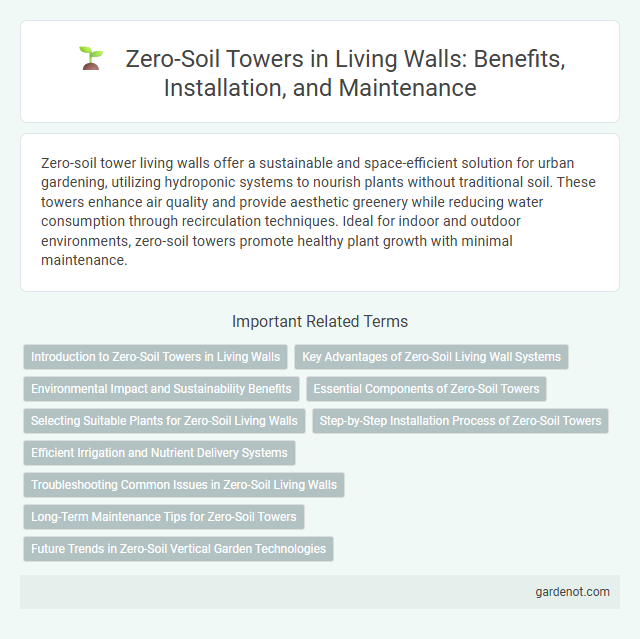Zero-soil tower living walls offer a sustainable and space-efficient solution for urban gardening, utilizing hydroponic systems to nourish plants without traditional soil. These towers enhance air quality and provide aesthetic greenery while reducing water consumption through recirculation techniques. Ideal for indoor and outdoor environments, zero-soil towers promote healthy plant growth with minimal maintenance.
Introduction to Zero-Soil Towers in Living Walls
Zero-soil towers in living walls utilize a soilless medium such as coco coir, perlite, or hydrogel to support plant growth while maximizing water retention and nutrient delivery. These systems employ vertical stacking to optimize space, making them ideal for urban environments with limited ground area. Advanced irrigation and aeration techniques ensure robust plant health and sustainability without soil-related complications.
Key Advantages of Zero-Soil Living Wall Systems
Zero-soil living wall systems utilize aeroponic technology, which significantly reduces water consumption by up to 90% compared to traditional soil-based methods. These systems enhance plant growth rates and health through precise nutrient delivery, resulting in cleaner, more efficient urban green spaces. The modular design of zero-soil towers allows for easy installation, maintenance, and scalability in both residential and commercial environments.
Environmental Impact and Sustainability Benefits
Zero-soil tower systems significantly reduce water consumption by utilizing aeroponics or hydroponics, minimizing soil erosion and runoff. These vertical gardens enhance urban air quality by increasing oxygen levels and capturing airborne pollutants. Their compact design supports biodiversity while conserving space, promoting sustainable urban agriculture and reducing carbon footprints.
Essential Components of Zero-Soil Towers
Essential components of zero-soil towers include a robust frame structure, a nutrient delivery system, and a water recirculation mechanism. The frame supports vertical plant growth, while the nutrient delivery system supplies essential minerals directly to the roots without soil. Efficient water recirculation minimizes waste and ensures consistent hydration, promoting sustainable and healthy plant development.
Selecting Suitable Plants for Zero-Soil Living Walls
Selecting suitable plants for zero-soil living walls involves prioritizing species with strong adaptability to hydroponic or aeroponic systems, such as pothos, ferns, and philodendrons. These plants thrive in nutrient-rich water environments while maintaining efficient root oxygenation and moisture absorption. Optimal plant selection ensures healthy growth, reduces maintenance needs, and enhances the aesthetic and air-purifying benefits of zero-soil towers.
Step-by-Step Installation Process of Zero-Soil Towers
Install the zero-soil tower by first selecting a stable, well-lit location suitable for vertical growth. Assemble the modular components according to the manufacturer's guidelines, ensuring secure attachment of each chamber designed to hold nutrient-rich water instead of soil. Finally, integrate the irrigation system to provide consistent moisture, and plant desired vegetation directly into the tower's growth pockets, optimizing space and promoting healthy development.
Efficient Irrigation and Nutrient Delivery Systems
Zero-soil towers utilize advanced efficient irrigation systems such as drip and aeroponic technologies to optimize water usage and ensure precise nutrient delivery. These systems minimize water waste while promoting faster plant growth and higher yields by directly targeting root zones. Integration of automated sensors further enhances nutrient management, adjusting delivery based on real-time plant needs and environmental conditions.
Troubleshooting Common Issues in Zero-Soil Living Walls
Zero-soil towers in living walls often face root rot and nutrient imbalance due to excess moisture retention and inadequate drainage systems. Regular monitoring of water flow rates and maintaining proper aeration within the substrate significantly reduces fungal growth and promotes healthy root development. Utilizing sensors for moisture and pH levels enables early detection of problems, ensuring optimal plant health and longevity in zero-soil environments.
Long-Term Maintenance Tips for Zero-Soil Towers
Regularly monitor the moisture levels of zero-soil towers to prevent root dehydration or waterlogging, ensuring optimal plant health. Implement a consistent nutrient delivery schedule with balanced hydroponic solutions to support sustained growth without soil. Inspect the system for algae buildup and mechanical wear to maintain efficient aeration and water circulation, extending the lifespan of the living wall.
Future Trends in Zero-Soil Vertical Garden Technologies
Zero-soil tower systems represent a breakthrough in vertical gardening by utilizing aeroponic and hydroponic technologies that eliminate the need for traditional soil substrates, optimizing space and resource efficiency. Future trends in zero-soil vertical garden technologies focus on integrating smart sensors and AI-driven irrigation controls to enhance plant health monitoring and reduce water consumption significantly. Advances in lightweight, modular materials promise easier installation and scalability, making zero-soil towers increasingly viable for urban agriculture and sustainable building designs.
Zero-soil tower Infographic

 gardenot.com
gardenot.com